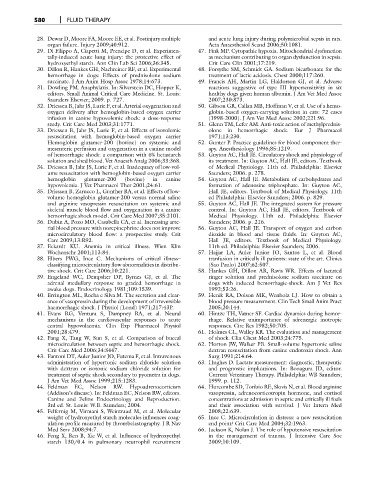Page 593 - Fluid, Electrolyte, and Acid-Base Disorders in Small Animal Practice
P. 593
580 FLUID THERAPY
28. Dewar D, Moore FA, Moore EE, et al. Postinjury multiple and acute lung injury during polymicrobial sepsis in rats.
organ failure. Injury 2009;40:912. Acta Anaesthesiol Scand 2006;50:1081.
29. Di Filippo A, Ciapetti M, Prencipe D, et al. Experimen 47. Fink MP. Cytopathic hypoxia. Mitochondrial dysfunction
tally-induced acute lung injury: the protective effect of as mechanism contributing to organ dysfunction in sepsis.
hydroxyethyl starch. Ann Clin Lab Sci 2006;36:345. Crit Care Clin 2001;17:219.
30. Dillon R, Hankes GH, Nachreiner RF, et al. Experimental 48. Forsythe SM, Schmidt GA. Sodium bicarbonate for the
hemorrhage in dogs: Effects of prednisolone sodium treatment of lactic acidosis. Chest 2000;117:260.
succinate. J Am Anim Hosp Assoc 1978;14:673. 49. Francis AH, Martin LG, Haldorson GJ, et al. Adverse
31. Dowling PM. Anaphylaxis. In: Silverstein DC, Hopper K, reactions suggestive of type III hypersensitivity in six
editors. Small Animal Critical Care Medicine. St. Louis: healthy dogs given human albumin. J Am Vet Med Assoc
Saunders Elsevier; 2009. p. 727. 2007;230:873.
32. Driessen B, Jahr JS, Lurie F, et al. Arterial oxygenation and 50. Gibson GR, Callan MB, Hoffman V, et al. Use of a hemo
oxygen delivery after hemoglobin-based oxygen carrier globin-based oxygen-carrying solution in cats: 72 cases
infusion in canine hypovolemic shock: a dose-response (1998-2000). J Am Vet Med Assoc 2002;221:96.
study. Crit Care Med 2003;31:1771. 51. Glenn TM, Lefer AM. Anti-toxic action of methylprednis
33. Driessen B, Jahr JS, Lurie F, et al. Effects of isovolemic olone in hemorrhagic shock. Eur J Pharmacol
resuscitation with hemoglobin-based oxygen carrier 1971;13:230.
Hemoglobin glutamer-200 (bovine) on systemic and 52. Gunter P. Practice guidelines for blood component ther
mesenteric perfusion and oxygenation in a canine model apy. Anesthesiology 1996;85:1219.
of hemorrhagic shock: a comparison with 6% hetastarch 53. Guyton AC, Hall JE. Circulatory shock and physiology of
solution and shed blood. Vet Anaesth Analg 2006;33:368. its treatment. In: Guyton AC, Hall JE, editors. Textbook
34. Driessen B, Jahr JS, Lurie F, et al. Inadequacy of low-vol of Medical Physiology. 11th ed. Philadelphia: Elsevier
ume resuscitation with hemoglobin-based oxygen carrier Saunders; 2006. p. 278.
hemoglobin glutamer-200 (bovine) in canine 54. Guyton AC, Hall JE. Metabolism of carbohydrates and
hypovolemia. J Vet Pharmacol Ther 2001;24:61. formation of adenosine triphosphate. In: Guyton AC,
35. Driessen B, Zarucco L, Gunther RA, et al. Effects of low- Hall JE, editors. Textbook of Medical Physiology. 11th
volume hemoglobin glutamer-200 versus normal saline ed Philadelphia: Elsevier Saunders; 2006. p. 829.
and arginine vasopressin resuscitation on systemic and 55. Guyton AC, Hall JE. The integrated system for pressure
skeletal muscle blood flow and oxygenation in a canine control. In: Guyton AC, Hall JE, editors. Textbook of
hemorrhagic shock model. Crit Care Med 2007;35:2101. Medical Physiology. 11th ed. Philadelphia: Elsevier
36. Dubin A, Pozo MO, Casabella CA, et al. Increasing arte Saunders; 2006. p. 216.
rial blood pressure with norepinephrine does not improve 56. Guyton AC, Hall JE. Transport of oxygen and carbon
microcirculatory blood flow: a prospective study. Crit dioxide in blood and tissue fluids. In: Guyton AC,
Care 2009;13:R92. Hall JE, editors. Textbook of Medical Physiology.
37. Eckardt KU. Anemia in critical illness. Wien Klin 11th ed. Philadelphia: Elsevier Saunders; 2006.
Wochenschr 2001;113:84. 57. Hajjar LA, Auler Junior JO, Santos L, et al. Blood
38. Elbers PWG, Ince C. Mechanisms of critical illness– tranfusion in critically ill patients: state of the art. Clinics
classifying microcirculatory flow abnormalities in distribu (Sao Paulo) 2007;62:507.
tive shock. Crit Care 2006;10:221. 58. Hankes GH, Dillon AR, Ravis WR. Effects of lactated
39. Engeland WC, Dempsher DP, Byrnes GJ, et al. The ringer solution and prednisolone sodium succinate on
adrenal medullary response to graded hemorrhage in dogs with induced hemorrhagic-shock. Am J Vet Res
awake dogs. Endocrinology 1981;109:1539. 1992;53:26.
40. Errington ML, Rocha e Silva M. The secretion and clear 59. Henik RA, Dolson MK, Wenholz LJ. How to obtain a
ance of vasopressin during the development of irreversible blood pressure measurement. Clin Tech Small Anim Pract
haemorrhagic shock. J Physiol (Lond) 1971;217:43P. 2005;20:144.
41. Evans RG, Ventura S, Dampney RA, et al. Neural 60. Hintze TH, Vatner SF. Cardiac dynamics during hemor
mechanisms in the cardiovascular responses to acute rhage. Relative unimportance of adrenergic inotropic
central hypovolaemia. Clin Exp Pharmacol Physiol responses. Circ Res 1982;50:705.
2001;28:479. 61. Holmes CL, Walley KR. The evaluation and management
42. Fang X, Tang W, Sun S, et al. Comparison of buccal of shock. Clin Chest Med 2003;24:775.
microcirculation between septic and hemorrhagic shock. 62. Horton JW, Walker PB. Small-volume hypertonic saline
Crit Care Med 2006;34:S447. dextran resuscitation from canine endotoxin shock. Ann
43. Fantoni DT, Auler Junior JO, Futema F, et al. Intravenous Surg 1991;214:64.
administration of hypertonic sodium chloride solution 63. Hughes D. Lactate measurement: diagnostic, therapeutic
with dextran or isotonic sodium chloride solution for and prognostic implications. In: Bonagura JD, editor.
treatment of septic shock secondary to pyometra in dogs. Current Veterinary Therapy. Philadelphia: WB Saunders;
J Am Vet Med Assoc 1999;215:1283. 1999. p. 112.
44. Feldman EC, Nelson RW. Hypoadrenocorticism 64. Hurcombe SD, Toribio RE, Slovis N, et al. Blood arginine
(Addison’s disease). In: Feldman EC, Nelson RW, editors. vasopressin, adrenocorticotropin hormone, and cortisol
Canine and Feline Endocrinology and Reproduction. concentrations at admission in septic and critically ill foals
3rd ed. St. Louis: W.B. Saunders; 2004. and their association with survival. J Vet Intern Med
45. Felfernig M, Virmani S, Weintraud M, et al. Molecular 2008;22:639.
weight of hydroxyethyl starch molecules influences coag 65. Ince C. Microcirculation in distress: a new resuscitation
ulation profile measured by thrombelastography. J R Nav end point? Crit Care Med 2004;32:1963.
Med Serv 2008;94:7. 66. Jackson K, Nolan J. The role of hypotensive resuscitation
46. Feng X, Ren B, Xie W, et al. Influence of hydroxyethyl in the management of trauma. J Intensive Care Soc
starch 130/0.4 in pulmonary neutrophil recruitment 2009;10:109.

